This week, we had the honour of collaborating on the 3rd annual Interface Management Conference in London, UK. The conference welcomed returning delegates and introduced new attendees representing 14 countries in oil & gas, power, nuclear, transportation, and infrastructure industries. It was great to see owners, EPCs, contractors, and service providers, including Maersk Oil, Aramco Overseas, Tullow Oil, Abu Dhabi Marine Operating Company, Saipem, Tecnimont, Subsea 7, FMC Technologies, Alstom, Network Rail, Wintershall, Kuwait Oil Company, CH2M Hill, Eni, and more.
Veja Mate A 400MW North Sea Project: Interface Management within the Offshore Wind Industry
Day one included several guest speakers from varying industries. Mads Bernitt, Interface Manager at Veja Mate took us through the process of installing a 400MW North Sea offshore windfarm. Although this is a relatively new industry for interface management, Mads was able to establish a practice and organization structure using novel techniques such as coffee machine team building! Offshore windfarms have a high degree of complexity and interfaces with topside, turbines, subsea foundations, and tiebacks to a substation over 100km from shore. Mads’ project includes four major packages and ten engineering companies and contractors. He spoke about the benefits of interface management for both large and small interfaces and the level of transparency it afforded management in reporting, forecasting, defining priorities, and identifying gaps in contracts.
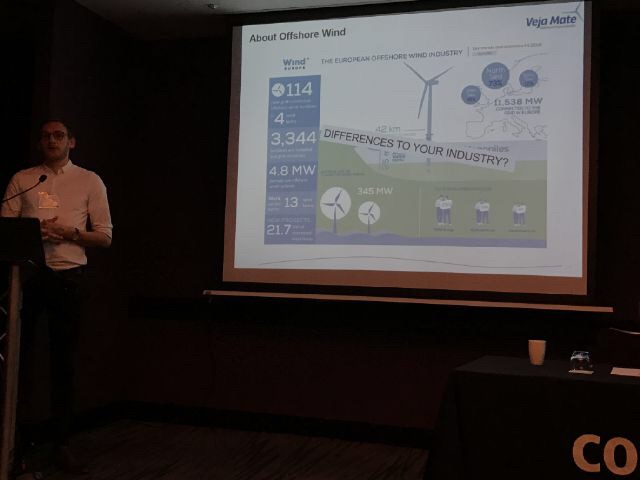
Mads Bernitt, Interface Manager, Offshore Project GmbH, Veja Mate, Lautec ApS discusses Veja Mate A 400MW North Sea Project: Interface Management within the Offshore Wind Industry
New Directions and New Tools for Interface Management
Dr. Sirous Yasseri, Senior Energy Researcher at Brunel University, took us through some new directions and tools for interface management. It was enlightening to get an academic viewpoint of interface management and the importance of putting the right components in the right order with the right relationships. Complex engineered systems are increasingly designed and built by geographically distributed teams stressing the need for careful definition of interfaces. Most of the problems and risk in systems are at the interfaces. Interfaces need special attention since each participant may make assumptions on behalf of the other and requires an ongoing discussion. Dr. Yasseri highlighted the need to understand dependencies and create four types of key interface documents: Interface Definition Document (IDD), Interface Requirement Document (IRD), Interface Control Document (ICD), and Interface Register (IR). At the end of the day, interface management is a procedure; the key to success is implementing it and managing it.
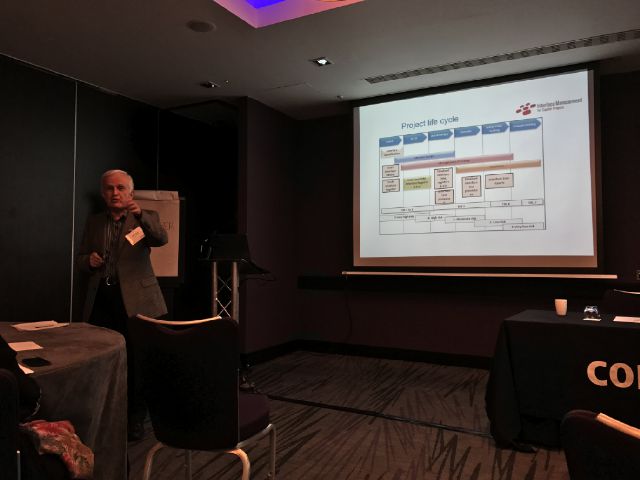
Sirous Yasseri, Senior Energy Researcher, Brunel University London, discussing new directions and new tools for interface management
Interactive Roundtable: Business Interruption of New Projects
Armando Bianco, Project Engineering Manager at Saipem, lead the first roundtable discussion: The Business Interruption of New Projects. There are many reasons for interruptions: planned, unplanned, and emergency. However, the consensus on the panel was that it is possible to plan the management of these interruptions and minimize the impact.
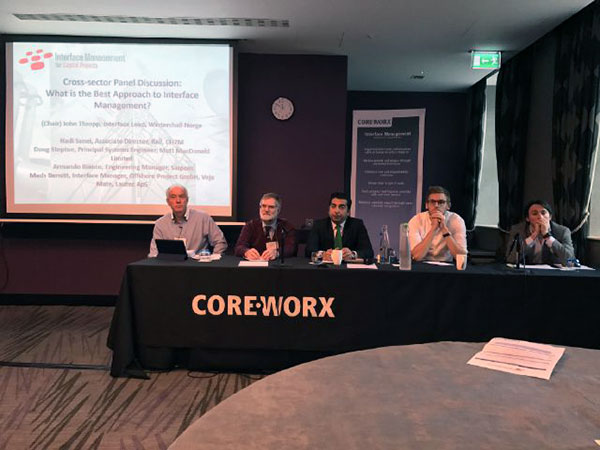
Interactive Roundtable: Business Interruption of New Projects
Overcoming Blockers to Effective Interface Management in the Rail Industry and Use of BIM (Building Information Modelling)
Delegates were happy to welcome Mott Macdonald back this year. Douglas Steptoe, Principal Systems Engineer, and Jon Stovell, Senior Systems Engineer, presented Overcoming Blockers to Effective Interface Management in the Rail Industry and use of Building Information Modelling (BIM). Interface management in rail does not only include the big interfaces (although those are the ones that make the news), but also include the small ones too. Douglas introduced new interface considerations, mentioning that keeping costs down can cause changes in contracting strategy and organizational design. It is important for the owner of the systems integration function to stipulate and follow a common interface management process even though individual companies may have their own versions to manage their scope packages. They discussed the UK BIM mandate of 2016 for public projects and using interface management to support coordination of areas in the stations to accommodate various types of equipment and layouts. It’s still early days with challenges in compatibility, affordability, and soft interfaces, but having an interface management program looks promising. Douglas and Jon stressed the importance of contractual enforcement of interface management, defining common interface processes and deliverables, as well as empowering the role of the interface manager.
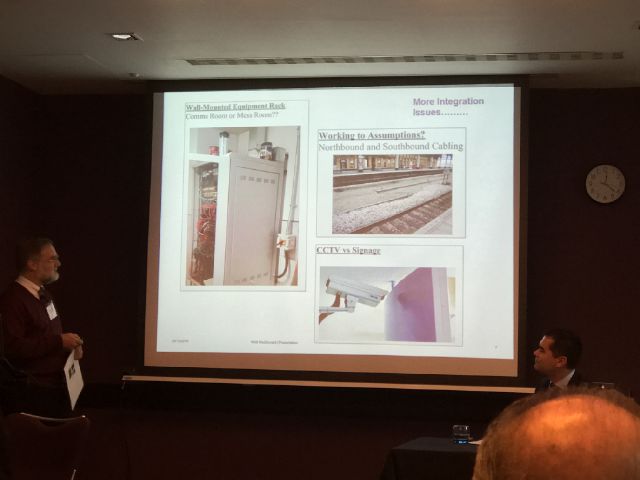
Douglas Steptoe, Principal Systems Engineer, and Jon Stovell, Senior Systems Engineer, Mott Macdonald presenting Overcoming Blockers to Effective Interface Management in the Rail Industry and Use of BIM (Building Information Modelling)
The Importance of Integrating Interface Management Solutions from the Onset: The Contractors View
Tom Haugen, Manager Project Interface, ER Projects at FMC Technologies, presented The Importance of Integrating Interface Management Solutions from the Onset – The Contractors View. In Tom’s extensive experience with interface management and his participation in thousands of meetings, it is clear to him that proactive interface management is of high importance and there is a high degree of difference between operators when it comes to interface management. Traceability and transparency are very important to control and track changes over time, especially as people come and go from the project. It is vital that the interface information is correct at all times during the execution phase as it is used for design and scope changes. He also described his long journey from starting interface management using Excel, then moving to local databases, and evolving to a web-based IMS systems that offer key functions needed for interface management successful.
Plant Disinvestment, Revamping and Shut-down: How Interface Management Follows the Project Strategy
Armando took the stage in the afternoon to take us through interface management programs in plant revamping and shutdowns. For revamping, also called shutdowns, turnarounds and outages (STOs), interfaces are mostly between operations and contractors with the goal to minimize downtime. There are two basic types of revamping projects: 1. Rehabilitation, and 2. Product Enhancement with new systems & tie-ins. Information needs to be gathered from operations, new site surveys need to be performed and then included in the new engineering and tie-in packages. Also of key importance is managing reservations, sometimes called permit to work. Operational considerations such as shutdown procedures, isolation, and start-up sequences need to be incorporated along with commissioning. Shutdowns are planned in hours instead of days, so plans are often made by reversing from the start-up deadline. Scope and work split needs to be clear between contractors and operations to avoid operational risk and impacting ongoing operations.
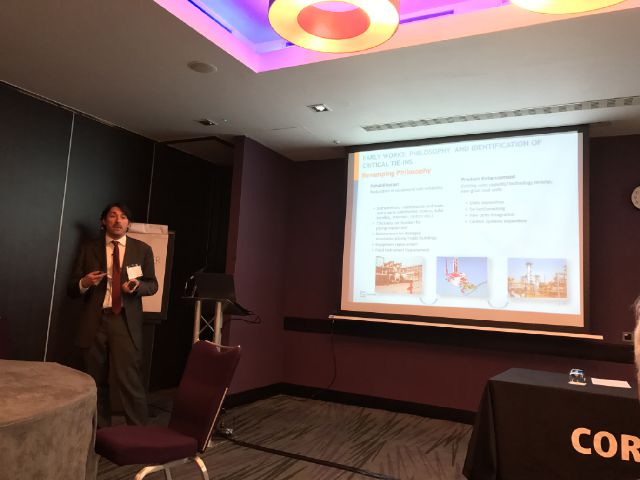
Armando Bianco, Engineering Manager, Saipem discussing Plant Disinvestment, Revamping and Shut-down: How Interface Management Follows the Project Strategy
Reducing the Impact of Human Error with Technology
Muhannad Abu Saleh, Senior Project Engineer at Petrofac, presented his thoughts on reducing the impact of human error using technology. Muhannad argued that there is a difference between human error, violation, and non-compliance behaviours. Errors rise as complexity and volume of activities increase in projects. An open culture combined with an easily accessible information system and well-developed interface management checklists are the elements of a good solution. In order to reduce and prevent human errors, methods such as skills training, better communications systems, improved processes, and good software tools are imperative.
Strategy, System and Structure in Interface Management
A good friend of Coreworx and veteran conference speaker, John Thropp, Interface Lead at Wintershall Norge, finished up the day with his talk on Strategy, Systems, and Structure in Interface Management. John took a utopian view on how to get to a desired end state:
- Start with a big picture view to develop an interface management plan. He mentioned a case where an owner who developed an internal interface program was expecting a 15% savings instead of paying an EPC to manage interfaces. Avoiding unexpected problems, can save up to 10x more!
- Do everything you can to get the contract right in terms of processes, information exchange, reference documents, and timelines relative to interface management.
- Communications – determine up front who needs to talk to who.
- Avoid duplications and gaps in scope with focus on battery limits, interface points, and statement of works (SOWs).
- Choose the right system tool: please do not use Excel or email! Get a proper web-based interface management solution, it is good value for the money.
- Projects are planned and executed by people: do not forget to have face-to-face meetings at least some of the time with a global alignment meeting at least once a year.
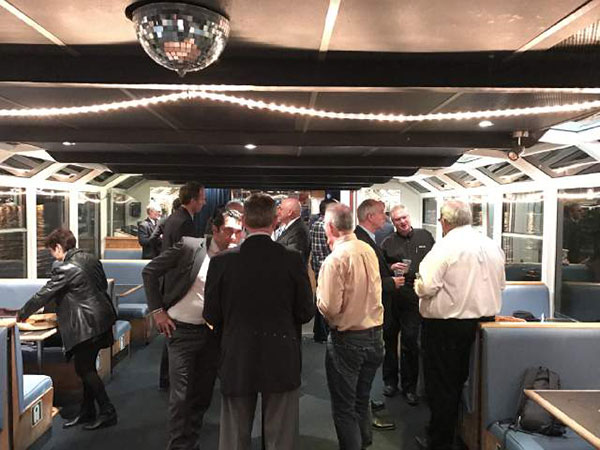
After an action-packed day, delegates and speakers alike boarded a boat tour to unwind. The group enjoyed the sights and sounds of beautiful London while continuing discussions from the day’s proceedings and getting ready for Day 2.
Interface Management Conference Presentations
If you are interested in any of the presentations from the 2016 Interface Management conference, please email info@coreworx.com.

Let Us Know What You Thought about this Post.
Put your Comment Below.